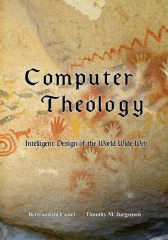PRESS
COMPUTER THEOLOGY |
||||
|
systems, policy definitions
and processes are artifacts of the societal extensions of the natural world
introduced by the human species. Policy in this environment is defined by and
applied by social systems and their intersection with the physical world. If
one views computers from the purely materialistic perspective, then the primary
area of this intersection is through the social structure termed the
marketplace. Thus, as we seek to establish an understanding of this area of
intersection, we need to have at least cursory knowledge of how the distinct
environments of the relevant species actually work. To that end, we will
consider first the mechanisms applicable to the distinct species; that is the
topic of this chapter. In the next chapter, we will consider the environments
themselves within which the individuals of the species interact. Evolutionary progression comes to organic species through two distinct
collections of processes. One set allows change and evaluation to occur within
the biophysical makeup of the individual entity within any species. Studies and
references to the origin of an individual from its seminal existence as a germ
cell through its maturation as an adult member of a species are termed ontogeny.
A second set of processes allows for change to individual members of a species,
or groups of these members through the interaction of the entities with their
containing environment across generations. The origin and development of a set
of entities within a species or even collections of such sets is termed phylogeny.
A concept we’ll revisit from time to time is that ontogeny, in some instances
and in some limited fashion, reflects phylogeny. The growth sequence of a
specific animal may reflect some characteristics of the sequence that led to
that animal’s species appearance on earth over millions of years. Similarly,
the organization of a network management structure in a modern computer
reflects the sequence of network technology improvements that led to that
computer species’ appearance over the past decades. In order for the evaluation process to have any bearing on future
development directions, either of organic life or of computer systems, there
must be a means of defining the structure of each that can be influenced by the
evaluation process. In essence, there must be a language through which the
policy, that is the means and mechanisms of existence, can be codified over
time; perhaps over a very long time. In the case of living organisms, the most
basic language of policy is that found within the DNA molecule, and the
resultant evaluation method is the application of physical processes to the
resultant living entities. This constitutes the process or collection of
processes generally referred to as natural
selection. For computer systems, the language of policy is perhaps more
arcane. It certainly is more ambiguous and nuanced. It is actually an amalgam
of the languages of design and manufacture, along with the languages of
interaction, including interactions among people, among people and machines,
and among machines. For the computer, the basic policy evaluation environment
is the market within which and for which computer systems are developed and
deployed. This is an environment purely defined by people as it encompasses
their interactions with each other and their interactions with computers. It
would seem that for group associations of both the human species and of
computer systems, the languages of policy are largely products of cognitive
development. This is an assessment that we will explore at some depth during
the course of this book. Let us then consider very briefly the mechanisms and mechanics of the evolution of living organisms. As we noted in the last chapter, this will entail a rather simplistic lesson in biology. It is useful for us to highlight certain characteristics central to the processes of change evocation that present during the act of cellular replication Based on this cursory view of organic processes, we will then consider the basic mechanisms that have thus far guided the progression of computer systems. We must point out that any of these processes or mechanisms must operate within an environment or framework comprised of both living and non-living components; a concept that is generally termed an ecosystem. We’ll consider the definition and characteristics of an ecosystem |
||||
|
||||
© Midori Press, LLC, 2008. All rights reserved for all countries. (Inquiries) The contents of ComputerTheology: Intelligent Design of the World Wide Web are presented for the sole purpose of on-line reading to allow the reader to determine whether to purchase the book. Reproduction and other derivative works are expressly forbidden without the written consent of Midori Press. Legal deposit with the US Library of Congress 1-33735636, 2007.
|
ComputerTheology Intelligent Design of the World Wide Web Bertrand du Castel and Timothy M. Jurgensen Midori Press, Austin Texas 1st Edition 2008 (468 pp) ISBN 0-9801821-1-5 |
Book available at Midori Press (regular) |
